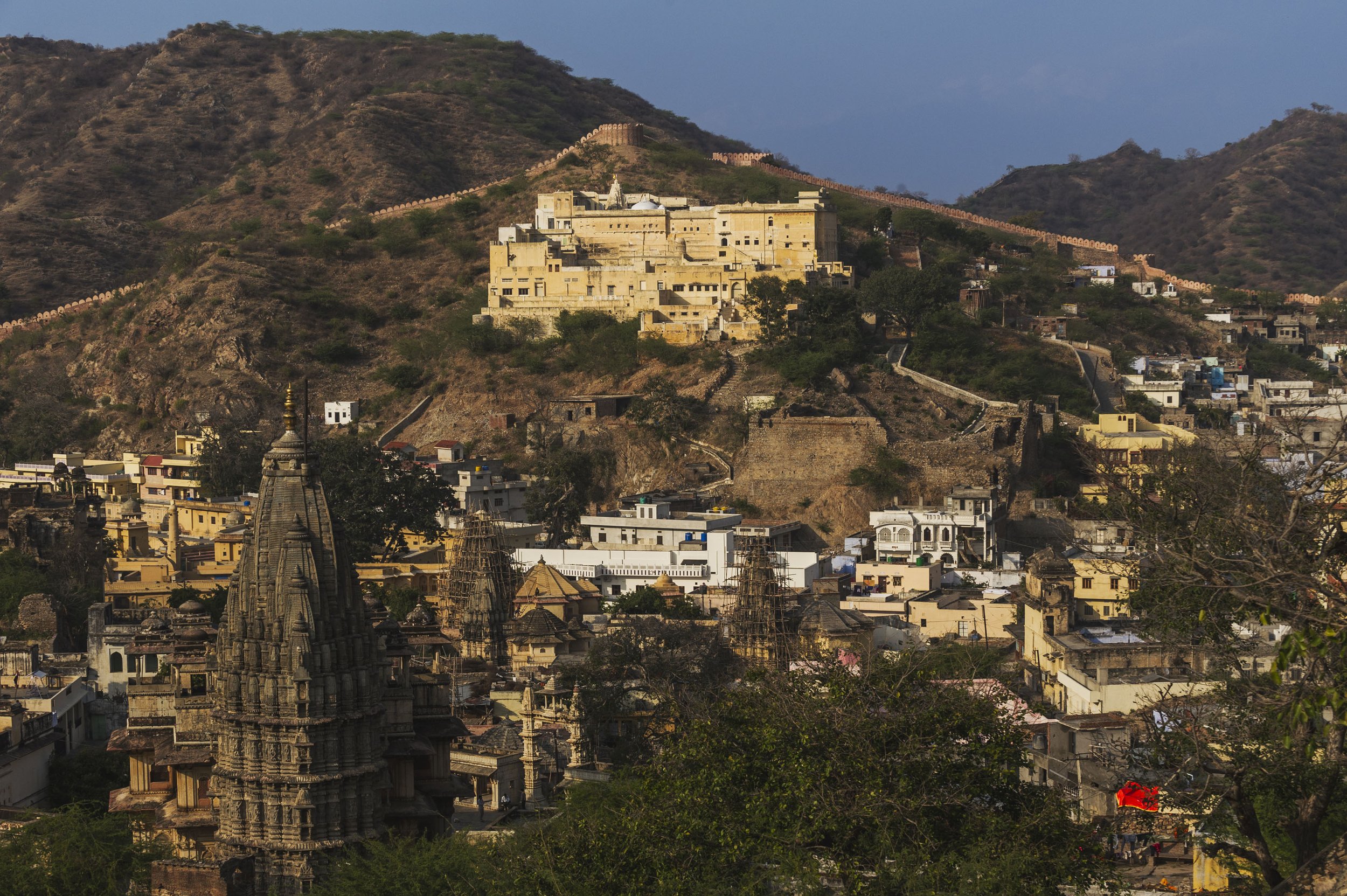India 2013
Jaipur, Rajasthan

Jaipur, the vibrant capital of Rajasthan, India, is a city steeped in history, culture, and architectural marvels. One of its most iconic landmarks is the magnificent Amber Fort, a UNESCO World Heritage Site nestled atop the Aravalli Hills, just outside the city.
Amber Fort, also known as Amer Fort, is a majestic fusion of Hindu and Mughal architectural styles, reflecting the rich cultural heritage of the region. Built in the 16th century by Raja Man Singh I, the fort served as the capital of the Kachwaha Rajputs before Jaipur was established.
As visitors approach the fort, they are greeted by its imposing walls, adorned with intricate frescoes, carvings, and mirror work, showcasing the exquisite craftsmanship of bygone eras. The fort's main entrance, Suraj Pol or Sun Gate, is a grand gateway leading to a series of courtyards, palaces, and gardens within.
Beyond its architectural splendor, Amber Fort offers breathtaking panoramic views of the surrounding landscape, including the Maota Lake below and the rugged hills beyond. Visitors can also enjoy elephant rides up to the fort, adding an element of regal charm to their experience.
Amber Fort stands as a testament to Jaipur's rich history and architectural legacy, captivating visitors with its grandeur and timeless beauty. A visit to this historic marvel is a journey back in time, offering a glimpse into the opulent lifestyle of Rajasthan's erstwhile royalty and the enduring spirit of its people.
Jaipur, Rajasthan
Jaipur, Rajasthan
Jaipur, Rajasthan
Jaipur, Rajasthan
Jaipur, Rajasthan
Jaipur, Rajasthan
Amber Fort
Amber Fort, also known as Amer Fort, stands as an enduring symbol of Rajasthan's rich history and architectural splendor. Situated atop the Aravalli Hills, just outside Jaipur, the fort offers a captivating blend of Hindu and Mughal influences, reflecting the region's cultural diversity and royal legacy.
The origins of Amber Fort can be traced back to the 16th century when it was commissioned by Raja Man Singh I, one of the trusted generals of Emperor Akbar. Built as a stronghold for the Kachwaha Rajputs, the fort served as their primary residence until the capital was shifted to Jaipur in the 18th century.
Constructed from red sandstone and marble, Amber Fort is a stunning example of Rajput architecture, characterized by its imposing walls, ornate gateways, and intricate artwork. The fort's strategic location atop a hill provided natural defense against invaders, while its elaborate layout offered resplendent living quarters for the royal family and their court.
As visitors approach Amber Fort, they are greeted by its majestic entrance, Suraj Pol or Sun Gate, adorned with intricate frescoes and decorative elements. Beyond the gate lies a series of courtyards, palaces, and gardens, each more enchanting than the last.
One of the highlights of a tour of Amber Fort is the Sheesh Mahal, or Palace of Mirrors, a dazzling chamber adorned with thousands of tiny mirrors that reflect light in a mesmerizing display. The Diwan-i-Khas, or Hall of Private Audience, and the Diwan-i-Aam, or Hall of Public Audience, offer insights into the courtly rituals and ceremonies of the Rajput rulers.
Visitors to Amber Fort can also enjoy panoramic views of the surrounding landscape, including the picturesque Maota Lake below and the rugged hills stretching into the distance. Additionally, the fort offers the opportunity to experience the regal charm of an elephant ride, adding to the sense of grandeur and romance.
Today, Amber Fort stands as a UNESCO World Heritage Site and a must-visit destination for travelers seeking to immerse themselves in the rich history and architectural marvels of Rajasthan. Its timeless beauty and cultural significance continue to enchant visitors from around the world, ensuring its place as a cherished symbol of India's royal heritage.
Amber Fort in Jaipur, Rajasthan
Amber Fort in Jaipur, Rajasthan
Amber Fort in Jaipur, Rajasthan
Amber Fort in Jaipur, Rajasthan
Amber Fort in Jaipur, Rajasthan
Amber Fort in Jaipur, Rajasthan
Amber Fort in Jaipur, Rajasthan
Amber Fort in Jaipur, Rajasthan
Amber Fort in Jaipur, Rajasthan
Amber Fort in Jaipur, Rajasthan
Amber Fort in Jaipur, Rajasthan
Amber Fort in Jaipur, Rajasthan
Amber Fort in Jaipur, Rajasthan
Amber Fort in Jaipur, Rajasthan
Amber Fort in Jaipur, Rajasthan
Amber Fort in Jaipur, Rajasthan
Amber Fort in Jaipur, Rajasthan
Amber Fort in Jaipur, Rajasthan
Jal Mahal
Jal Mahal, or the Water Palace, is an architectural gem nestled in the midst of Man Sagar Lake in Jaipur, the capital city of Rajasthan, India. This picturesque palace is renowned for its unique location, where it appears to float serenely on the tranquil waters of the lake, creating a mesmerizing sight that attracts visitors from far and wide.
The history of Jal Mahal dates back to the 18th century when it was commissioned by Maharaja Madho Singh I of Jaipur. Built in the Rajput architectural style, the palace served as a royal retreat and hunting lodge for the Maharajas of Jaipur. Its strategic location amidst the lake provided a serene and private sanctuary for the royal family to enjoy leisurely activities such as boating and bird watching.
Jal Mahal is a five-story structure, with four floors submerged under water when the lake is full, leaving only the top floor visible. The palace is built using red sandstone, with intricately carved balconies, arched doorways, and ornate domes that showcase the craftsmanship of Rajput artisans. The exterior of the palace is adorned with delicate floral motifs and geometric patterns, adding to its architectural charm.
While the lower floors of Jal Mahal remain submerged throughout the year, the upper floor offers panoramic views of the surrounding Aravalli hills and the cityscape of Jaipur. Visitors can admire the beauty of the palace from a distance or take a boat ride on the lake to get a closer look at this architectural marvel.
Over the years, Jal Mahal has undergone restoration efforts to preserve its historic charm and architectural integrity. Today, it stands as a symbol of Jaipur's rich cultural heritage and architectural legacy, offering visitors a glimpse into the opulent lifestyle of the Rajput rulers.
Jal Mahal is not open to the public for interior exploration, but its enchanting beauty and serene surroundings make it a popular destination for photography enthusiasts, nature lovers, and history buffs alike. Whether admired from afar or experienced up close, Jal Mahal continues to captivate visitors with its timeless elegance and mystique.
Jal Mahal in Jaipur, Rajasthan
Jal Mahal in Jaipur, Rajasthan
Jal Mahal in Jaipur, Rajasthan



























